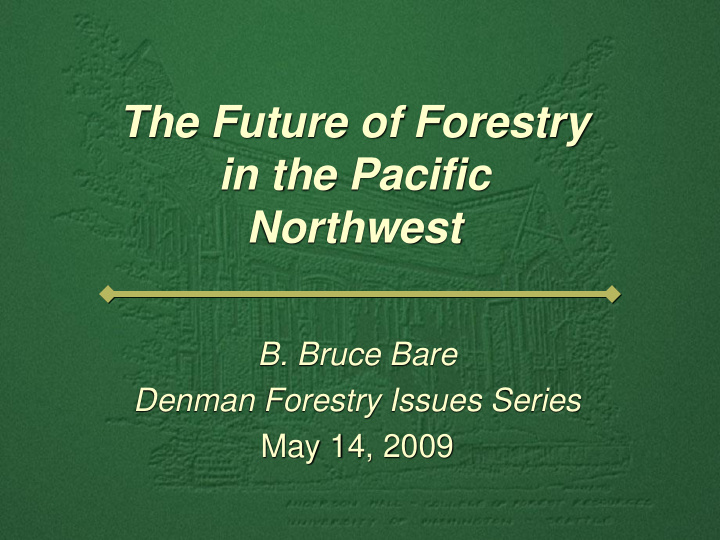



The Future of Forestry in the Pacific Northwest B. Bruce Bare Denman Forestry Issues Series May 14, 2009
The Future of Forestry in the PNW ◼ Topics to discuss ◼ Historic transition affecting natural resources and forest management ◼ Forces that are impacting future change ◼ Overview of Washington’s forests ◼ Major issues and opportunities 2
Changing Nature of Forestry in the PNW ◼ 21 st Century ◼ 19 th - 20 th Centuries ◼ Ecosystem Model ◼ Agricultural Model ◼ Eco-centric ◼ Utilitarian ◼ State oriented view ◼ Output oriented view ◼ Forest productivity ◼ Forest resiliency ◼ Stand level ◼ Landscape level ◼ Timber primacy ◼ Multi-resource (sustained yield) (sustainability) ◼ Multiple use & ◼ Integrated use carrying capacity 3
Why a Paradigm Shift? ◼ Changing societal values of a growing, affluent, and urbanized population ◼ Growing awareness of the ecological and environmental implications of climate change and globalization of trade and business 4
Why a Paradigm Shift? ◼ Recognition that we live on a human dominated planet, where ◼ Both natural and man-caused disturbances play significant roles in ecosystem health and resiliency 5
Why a Paradigm Shift? ◼ Growing concern over loss of biodiversity in managed forests, fragmentation, invasive and endangered species, wildfire, clean water, recreation and forest health 6
21 st Century Environment ◼ Combined, these influences have had a significant impact on the way we view our forests and how society expects them to be treated in the future ◼ Creates opportunities for the future 7
College of Forest Resources: Mission ◼ Study and investigate the functionality and sustainability of natural resource systems ◼ Natural and managed environments ◼ Interdisciplinary approach across multiple spatial and temporal scales of urban, suburban and wildland landscapes 8
Sustainability ◼ Sustainability is the common goal as it includes all natural resources ◼ Dynamic equilibrium that balances ecological functions and conditions with social and economic factors of the needs of future generations as well as those of the present 9
The Future of Forestry in the PNW ◼ Topics to discuss ◼ Historic paradigm shift affecting natural resource management and forestry ◼ Forces that are impacting future change ◼ Overview of Washington’s forests ◼ Major issues and opportunities 10
Forces Driving Change ◼ Affluent and growing population with more leisure time and disposable income ◼ Global climate change ◼ Global trade ◼ Renewable energy from woody biomass ◼ Forest health and restoration ◼ Desire to enhance biodiversity 11
Washington State (OFM Estimate) 9,000,000 140.00 8,000,000 120.00 7,000,000 100.00 6,000,000 80.00 5,000,000 Population Density 4,000,000 60.00 3,000,000 40.00 2,000,000 20.00 1,000,000 0 0.00 12
The Future of Forestry in the PNW ◼ Topics to discuss ◼ Historic paradigm shift affecting natural resource management and forestry ◼ Forces that are impacting future change ◼ Overview of Washington’s forests ◼ Major issues and opportunities 13
Washington’s Forest Ownership Public: 44% Private: 56% ◼ Western Washington – 9.6 million acres (60%) ◼ Eastern Washington – 6.5 million acres (40%) ◼ Total -- 16 million acres (unreserved commercial timberland) and 22 million acres of total forest land 14
Washington Timber Inventory Ownership Public: 53% Private: 47% ◼ 60 billion cu. ft. of inventory (250 billion bd. ft.) ◼ For comparison: USA consumed 21.3 BCF in 2005 (domestic and imported wood supply) ◼ 1.5 billion cu. ft. annual growth (~6.3 BBF) ◼ 1.4 billion cu. ft. annual removals 15
Washington Timber Harvest (2003P) Public: 19%* Private: 81%** * WA DNR is 84% of the public harvest or 16% of the total ** Includes all private owners with/without conversion facilities (TIMOs, REITs, MLPs) and Native American 16
The Future of Forestry in the PNW ◼ Topics to discuss ◼ Historic paradigm shift affecting natural resource management and forestry ◼ Forces that are impacting future change ◼ Overview of Washington’s forests ◼ Major issues and opportunities 17
Issues and Opportunities ◼ Build collaborative institutional arrangements and organizational networks ◼ Recognize risk and uncertainty in decision making ◼ Constant change – no steady state 18
Issues and Opportunities ◼ Forests are being converted to non-forest uses – mostly private lands ◼ Excessive parcelization and fragmentation ◼ Lose of infrastructure of wood products industry ◼ Domestic and foreign competition are increasing and capturing market share 19
Issues and Opportunities ◼ Forest health: overly dense forests; reduced tree vigor; prone to disease and insect attack; increased risk of wildfire; loss of biodiversity ◼ Biomass conversion for energy and transportation fuels 20
Issues and Opportunities ◼ Land owner payments for ecosystem services -- carbon storage; biodiversity enhancements; water production; wildlife habitat; erosion control ◼ Direct development into rural villages or urban areas by using development rights ◼ Re-examine tax policy and regulations to reduce disincentives for working forests 21
Summary ◼ Entering a new era that will require new thinking and models of forest stewardship ◼ Future will be very different from the past with many exciting opportunities and challenges ◼ Need a highly educated professional work force to deal with complexities and trade- offs measured across the three metrics of sustainability 22
Recommend
More recommend